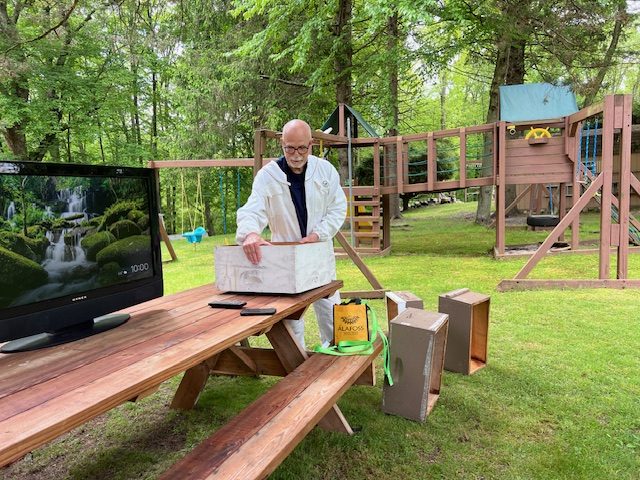Extracting honey can be a fun and educational event for family and friends. After taking a look at Eric’s professional way of extracting honey, here’s how backyard beekeepers extract honey.
Feel free to send us photos of your harvest. We can show them in one of the next posts here! Contact us.
How to remove bees from honeycombs?
There are several bee escapes (diamond, triangle) that you can buy or quickly build yourself that will empty the honey supers from bees over night.
DIY bee escape: the space between the slats is approximately 0.4 inches. The slats are also about 0.4×0.4 inches. Then you only need a fine grid and the bee escape is ready (photos attached). We had 5 bees left in the super after 12 hours. But keep in mind, they learn. If the bee escape is in the hive for too long, the bees could find their way back into the honey super.
How do I uncap the honeycomb?
If you just have a few hives, the uncapping knife and an uncapping fork will work great. You can consider placing the knife in hot water before each use. You will have a lot of uncapping wax. This wax is the purest and highest quality as it has not been in contact with the brood. I also recommend that no pesticides are used during the honey flow so that there are no residues in the wax.
Ever thought of making candles, furniture polish, lip balm, skin protection cream, shoe polish, wax cloths, propolis tincture – you name it!
Honey extraction
There is a refractometer which tells you how dry the honey is. Capped honey is usually ripe. Honey should have a maximum water content of 20%, ideally less than 17.5%. A higher water content can occur if some uncapped honey (nectar) is spun because not all the honeycombs have been capped. Honey with such a high water content can ferment.
We have a manual honey extractor for 3 frames and use wax foundations. Spin slowly and don’t go to high speed. Turn the combs. Now that some of the honey is out, you can spin fully. At the end, turn again and spin.
Check the tank from time to time as the honey may rise to the point where the frames are in the honey. Before this happens, it is advisable to drain the honey for the next spin.
Hygiene
Be careful not to leave honeycombs outside, as this can trigger robbery or other undesired guests.
Disinfect all utensils that will come into contact with the honey or boil them in water before use.
Remove wax residue with cold water, otherwise it will smear and leave a mess.































